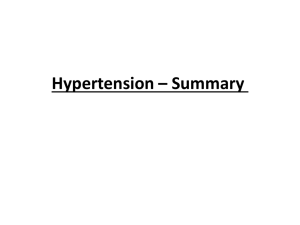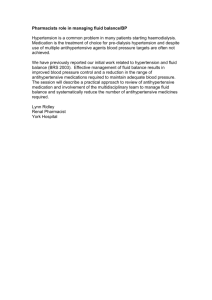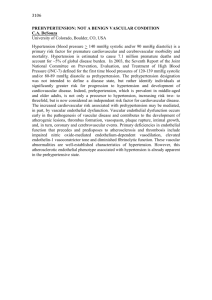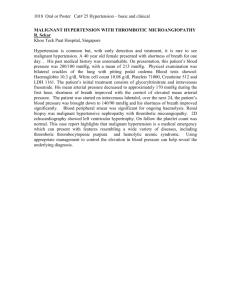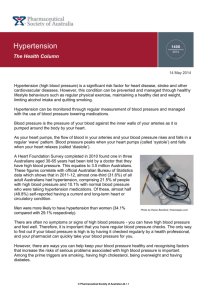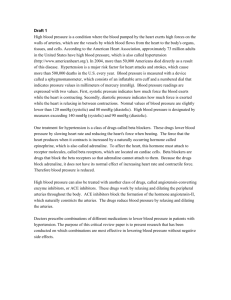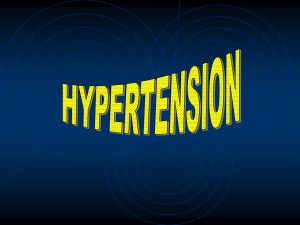Pharmacology of Antihypertensive Agents
advertisement
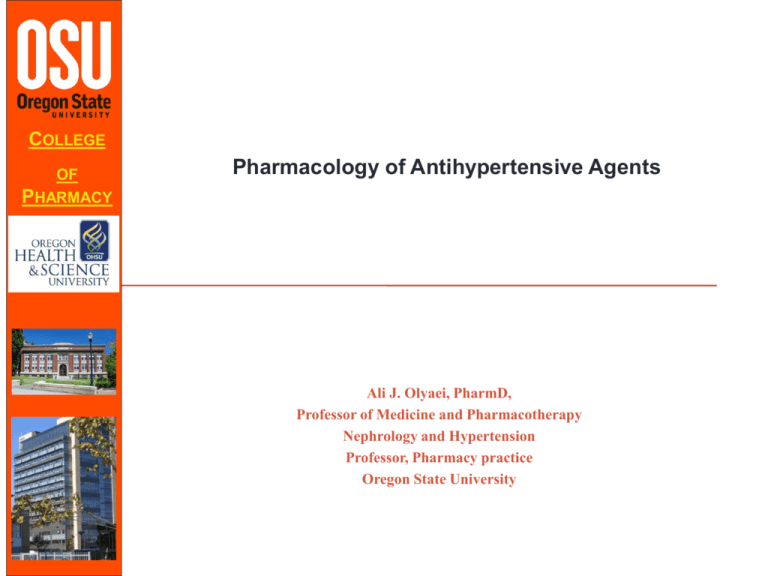
COLLEGE OF Pharmacology of Antihypertensive Agents PHARMACY Ali J. Olyaei, PharmD, Professor of Medicine and Pharmacotherapy Nephrology and Hypertension Professor, Pharmacy practice Oregon State University Conflict of Interest Disclosure Disclosure I do not have any financial relationships to disclose. Drug Class Prototype Drug Mechanism of Action Inhibits ACE - ↓ angiotensin II, ↑ bradykinin Hemodynamic Effects Adverse Drug Effects ACE Inhibitors Captopril Lisinopril Enalipiril Angiotensin II receptor Antagonists Calcium Channel Antagonists Beta Antagonists ↓ systemic vascular resistance and preload HTN w/1st dose, Cough & angioedema w/↑ kinin, renal impairment, hyperkalemia, Losartan Blocks angiotensin II receptor binding Vasodilation w/↓ preload ↓afterload Nifedipine Verapamil, diltiazem, Propranolol Bind Ca2+ channels ↓ Ca2+ for muscle contraction Non-selective β receptor blockade Cardioselective β1 receptor blockade Vasodilation Negative salt and water balance, ↑PGI2 synthesis & action, vasodilaton Metoprolol Diuretics Thiazides, Spironolactone Furosemide Vasodilators Drug-Drug Interactions NSAIDS, Lithium Drug-Disease Interactions Pregnancy no cough renal impairment, hyperkalemia, Constipation, peripheral edema, worsen CHF, headache Bad dreams, depression Cardio – worsen CHF and occlusive peripheral vascular disease (OPVD) Lungs – bronchospasm NSAIDS, Lithium Pregnancy Digoxin, β blockers = A-V block Unstable angina, MI, HTN? May interact w/CCBs or digoxin causing A-V block Asthma, COPD, severe heart failure, OPVD, high° A-V block Early drop in CO due to ↓volume Peripheral vascular resistance decreased Fluid and electrolyte imbalance, particularly hypokalemia with thiazides and loop diuretics, Hyperkalemia with spironolactone Furosemide mostly for fluid management NSAIDS, Lithium Chronic kidney disease ↓ Heart rate and contractility, ↑ systemic vascular resistance Ethacrynic acid, Patients with Sulfa allergy Hydralazine Relax vascular smooth muscle ? ↓ systemic vascular resistance Immuno – lupus like Sx Cardio - ↑ HR use β block Minoxidil Vasodilation - ↑ K+ channel hyperpolarize SM Causes NO release, relaxes SM ↓ systemic vascular resistance ↓ cardiac preload and afterload Cardio - ↑ HR use β block Fluid retention, Hypertrichosis Hypotension, cyanide and thiocyanate poisoning Na+ nitroprusside Central Agonists Clonidine Central α2a recptor stimulation ↓ CO, ↓ systemic vascular resistance Short ½life. Missed dose = rebound HTN Alpha Antagonists Prazosin Block peripheral α1 adrenoreceptors ↓ systemic vascular resistance Orthostatic HTN w/1st dose. Give 1st HS. Dopamine Agonist Fenoldopam Dopamine (DA) 1 agonist ↑ renal blood flow ↑Na+ excretion Kidney or liver disease Depression, sexual dysfunction HF IV only Lower SBP and DBP Is Better Ischemic Heart Disease Rates by SBP, DBP, and Age Diastolic Blood Pressure Systolic Blood Pressure Age at risk: 80-89 years 256 256 Age at risk: 80-89 years 128 70-79 years 128 70-79 years 64 60-69 years 64 60-69 years IHD 32 mortality (floating 16 bsolute 8 risk and 4 95% CI) 2 50-59 years 32 50-59 years 40-49 years 16 40-49 years 8 4 2 1 1 120 140 160 180 Usual SBP (mm Hg) CI, confidence interval; IHD, ischemic heart disease Lewington S et al. Lancet. 2002;360(9349):1903-1913. 70 80 90 100 110 Usual DBP (mm Hg) 2014 Hypertension Guideline Management Algorithm Adult aged > 18 years with hypertension Implement lifestyle interventions (continue throughout management) Set blood pressure goal and initiate blood pressure lowering-medication based on age, diabetes , and chronic kidney disease (CKD). General Population (no diabetes or CKD) Age > 60 years Diabetes or CKD present Age < 60 years All ages All ages Diabetes present No CKD CKD present with or without diabetes Blood Pressure Goal: Blood Pressure Goal: Blood Pressure Goal: Blood Pressure Goal: SBP < 150 mmHg SBP < 140 mmHg SBP < 140 mmHg SBP < 140 mmHg DBP < 90 mmHg DBP < 90 mmHg DBP < 90 mmHg DBP < 90 mmHg All Races Nonblack Initiate thiazide-type diuretic or ACEI or ARB or CCB, alone or in combination Black Initiate thiazide-type diuretic or CCB, alone or in combination Initiate ACEI or ARB, alone or in combination with other drug class. All-Cause Mortality in Participants with a History of Diabetes Mellitus or FG 126+ mg/dL at Baseline Cumulative Mortality Rate .28 .24 .2 HR (95% CI) p value A/C 0.95 (0.86-1.05) 0.33 L/C 0.99 (0.89-1.09) 0.69 .16 Chlorthalidone Amlodipine .12 Lisinopril .08 .04 0 0 1 2 3 4 Years to Death 5 6 7 Development Of Antihypertensive Therapies Effectiveness Tolerability 1940’s 1950 1957 1960’s Ganglion blockers Veratrum alkaloids 1980’s -blockers Direct vasodilators Peripheral sympatholytics 1970’s ARBs ACE inhibitors Thiazides diuretics Central 2 agonists Calcium antagonistsnon DHPs -blockers 1990’s Calcium antagonistsDHPs 2000 SABs Others 2010 DRI Cautions Regarding Antihypertensive Drug Therapy Be careful that you do not climb aboard a bandwagon that is headed for a cliff. ► Reserpine causes breast cancer ► Diuretics increase heart attack risk ► CCBs cause GI homorrhages and do not reduce CHD events ► ACE inhibitors should not be used in people with renal disease ► Diuretics cause ESRD ► B-blockers may no longer be indicated in the treatment of hypertension Multiple Antihypertensive Agents Needed to Achieve Target BP No. of Antihypertensive Agents Trial Target BP (mm Hg) 1 UKPDS DBP <85 ABCD DBP <75 MDRD MAP <92 HOT DBP <80 AASK MAP <92 IDNT <135/85 ALLHAT <140/90 2 3 Adapted from Bakris GL, et al. Am J Kidney Dis. 2000;36:646-661; Lewis EJ, et al. N Engl J Med. 2001;345:851-860; Cushman WC, et al. J Clin Hypertens. 2002;4:393-404; Brenner BM, et al. N Engl J Med. 2001;345:861-869. 4 Hypertension Education Program: Treatment Approaches: ► Lifestyle ► Pharmacological Lifestyle Therapies in Hypertensive Adults: Summary Intervention Target Reduce foods with added sodium < 100 mmol/day Weight loss BMI <25 kg/m2 Alcohol restriction Less or equal to 2 drinks/day Exercise at least 4 times/week Dietary patterns DASH diet Smoking cessation Smoke free environment Waist Circumference < 102 cm for men < 88 cm for women Patient Adherence • Nonadherence of patients to prescribed medication is a challenge in all chronic conditions, with typical adherence rates at 1 year of • About 50% for drugs • About 5-10% for lifestyle changes Haynes et al. JAMA. 2002;288:2880-2883. Antihypertensive Drugs • Diuretics: • Thiazides: Hydrochlorothiazide, chlorthalidone • High ceiling: Furosemide • K+ sparing: Spironolactone, triamterene and amiloride MOA: Acts on Kidneys to increase excretion of Na and H2O – decrease in blood volume – decreased BP • Angiotensin-converting Enzyme (ACE) inhibitors: • Captopril, lisinopril, enalapril, ramipril and fosinopril MOA: Inhibit synthesis of Angiotensin II – decrease in peripheral resistance and blood volume • Angiotensin (AT1) blockers: • Losartan, candesartan, valsartan and telmisartan MOA: Blocks binding of Angiotensin II to its receptors Antihypertensive Drugs • ß-adrenergic blockers: • Non selective: Propranolol (others: nadolol, timolol, pindolol, labetolol) • Cardioselective: Metoprolol (others: atenolol, esmolol, betaxolol) MOA: Bind to beta adrenergic receptors and blocks the activity • α – adrenergic blockers: • Prazosin, terazosin, doxazosin, phenoxybenzamine and phentolamine • MOA: Blocking of alpha adrenergic receptors in smooth muscles – vasodilatation • ß and α – adrenergic blockers: • Labetolol and carvedilol • Centrally acting: • Clonidine, methyldopa MOA: Act on central α2A receptors to decrease sympathetic outflow – fall in BP Antihypertensive Drugs • Calcium Channel Blockers (CCB): • Verapamil, diltiazem, nifedipine, felodipine, amlodipine, nimodipine etc. MOA: Blocks influx of Ca++ in smooth muscle cells – relaxation of SMCs – decrease BP • Vasodilators: • Arteriolar – Hydralazine (also CCBs and K+ channel activators) • Arterio-venular: Sodium Nitroprusside • K+ Channel activators: • Diazoxide, minoxidil, pinacidil and nicorandil MOA: Leaking of K+ due to opening – hyper polarization of SMCs – relaxation of SMCs What is the True Blood Pressure? Daytime BP? Dipping Pattern? Nighttime BP? Morning Surge? 24 Hr Average BP? Clinic BP? Variability of BP? Home BP? Angiotensin Converting Enzyme (ACE) Inhibitors What is Renin - Angiotensin? RAS Inhibition • Renin is a proteolytic enzyme and also called angiotensinogenase • It is produced by juxtaglomerular cells of kidney • It is secreted in response to: • Decrease in arterial blood pressure • Decrease Na+ in macula densa • Increased sympathetic nervous activity RAS Suppression when using ACEInhibitors, ARBs, or Diuretics Angiotensinogen Renin activity Angiotensin II Diuretic Compensatory feedback mechanisms Angiotensin I ACE ACE-independent pathways ACEI Volume depletion ARB AT1 Receptor Harmful effects AT2 Receptor Potential beneficial effects ARBs: How Do They Compare Indications Bioavailability Valsartan (Diovan) Losartan (Cozaar) Eprosartan (Tevetan) Telmisartan (Micardis) Irbesartan (Avapro) Olmesartan (Benicar) Candesartan (Atacand) Hypertension, Heart Failure Hypertension Hypertension Hypertension Hypertension Hypertension Hypertension 25% 33% Type II Type II 13% 42% - 40mg CHF 60-80% 26% 15% 58% - 160mg Peak Effect 2-4 hours L- 1 hour 1-2 hours 0-1 hour 1.5-2 hours 1-2 hours 3-4 hours 5-9 hours 24 hours 11-15 hours 13 hours 9-12 hours M – 3-4 hours Half Life 24 hours L-2 hours M-6-9 hours Metabolism AT1: AT2 Receptor Affinity Elimination Not Identified CYP 450 2C9, 3A4 Primarily unchanged Mostly unchanged 80% unchanged; 6% inactive metabolite Not CYP 450 unchanged 20,000:1 1,000:1 1,000:1 3,000:1 8,500:1 12,500:1 >10,000:1 83% feces 60% feces 90% feces >97% feces 67% feces 35% urine 7% urine 1% urine 20% urine, remainder urine 50-65% feces 13% urine 35-50% urine 33% urine RAAS Blockade Can Be Considered A Foundation of Combination Therapy RAAS Blocker + CCB* + Diuretic* ► Targets two key mechanisms of action: ● Pressure ● Neurohormonal ► Targets two key mechanisms of action ● Salt/volume ● Neurohormonal ► Additive efficacy ► Additive efficacy ► Excellent BP reduction in many demographic groups ► Excellent BP reduction in many demographic groups ► Potential safety/ tolerability benefits ► Potential safety/ tolerability benefits RAAS=renin-angiotensin-aldosterone system CCB=calcium channel blocker; BP=blood pressure *Versus either drug alone Weir MR. Am J Hypertens 1998;11:163S–169S. Calcium Channel Blockers – Classification (Verapamil, Diltiazem, Nifedipine, Amlodipine) Ca++ Channel Blockers Inhibit the inward movement of Ca++ by blocking voltagedependent Ca++ channels located in cell membranes. Ca++ channel antagonists Ca++ channel inhibitors Ca++ entry blockers etc…… Distinct families with diverse molecular structure: Phenylalkylamines, Benzothiazepines, Dihydropyridines (Verapamil, Diltiazem, Nifedipine, Amlodipine) Amlodipine Provides 24-Hour BP Efficacy Calcium Channel Blockers • Advantages: • Unlike diuretics no adverse metabolic effects but mild adverse • • • • • • effects like – dizziness, fatigue etc. Do not compromise hemodynamics – No sedation or CNS effect Can be given to asthma, angina and PVD patients No renal and limited male sexual function impairment No adverse fetal effects and can be given in pregnancy [nifedipine] Minimal effect on quality of life General Effects and Side Effects - Continued • Induce relaxation of arteriolar smooth muscle, but unlike other vasodilators, do not cause fluid retention. • However, cause peripheral edema (increased hydrostatic pressure in lower extremities due to pre-capillary dilation). Often cause ankle edema. • Headache, flushing, dizziness, nausea, peripheral edema (excessive vasodilation). • Especially efficacious in low-renin hypertension (black patients, elderly). • Efficacy is enhanced with concomitant use of diuretics and ACE inhibitors, • SE generally reduced with slow release forms. BP Response to instant-release Nifedipine Burton, T. J., and I. B. Wilkinson. "The dangers of immediate-release nifedipine in the emergency treatment of hypertension." Journal of human hypertension 22.4 (2008): 301-302. Adverse events reported with instant-release nifedipine Burton, T. J., and I. B. Wilkinson. "The dangers of immediate-release nifedipine in the emergency treatment of hypertension." Journal of human hypertension 22.4 (2008): 301-302. Diuretics • Drugs causing net loss of Na+ and water in urine • Mechanism of antihypertensive action: • Initially: diuresis – depletion of Na+ and body fluid volume – decrease in cardiac output • Subsequently after 4 - 6 weeks, Na+ balance and CO is regained by 95%, but BP remains low! • Q: Why? Answer: reduction in total peripheral resistance (TPR) due to deficit of little amount of Na+ and water (Na+ causes vascular stiffness) • Similar effect is seen with sodium restriction (low sodium diet) Diuretics From Birkenhäger, WH: Diuretics and blood pressure reduction: physiological aspects. J. Hyperten. 1990, 8 (Suppl 2) S3-S7. Thiazide diuretics – adverse effects • Adverse Effects: • Hypokalaemia – muscle pain and fatigue • Hyperglycemia: Inhibition of insulin release due to K+ depletion • • • • (proinsulin to insulin) – precipitation of diabetes Hyperlipidemia: rise in total LDL level – risk of stroke Hyperurecaemia: inhibition of urate excretion Sudden cardiac death – tosades de pointes (hypokalaemia) All the above metabolic side effects – higher doses (50 – 100 mg per day) • But, its observed that these adverse effects are minimal with low doses (12.5 to 25 mg) - Average fall in BP is 10 mm of Hg Thiazides and Related Diuretics Diuretics Dose Frequency (mg) Duration of Action (hours) Chlorthalidone 12.5-50 1/day 24-72 HCTZ 12.5-50 1-2/day 12-18 Metolazone 0.5-5 1/day 18-24 Indapamide 1.25-5 1/day 18-24 Systolic BP (mmHg) Mean Office BSP and Change During the First 8-week Study Period 150 145 140 135 130 125 120 115 Only significant at 2 weeks (15.7 vs 4.5 9=0001) 0 2 HCTZ (n=16) 4 Week 6 Chlorthalidone 8 (n=14) Adapted from Ernst, et al. (2006). Comparative antihypertensive effects of hydrochlorothiazide and chlorthalidone on ambulatory and office blood pressure. Hypertension. March 2006, p. (352-359) (mmHg) Change in Systolic BP Mean Change From Week 0 To Week 8 In Average Hourly Ambulatory Systolic BP 6 2 -2 -6 -10 -14 -18 -22 -26 6AM 10AM 12PM HCTZ 4PM 8PM 12PM Chlorthalidone Adapted from Ernst, et al. (2006). Comparative antihypertensive effects of hydrochlorothiazide and chlorthalidone on ambulatory and office blood pressure. Hypertension. March 2006, p. (352-359) Implications • Chlorthalidone has a much longer elimination half-life (24 to 55 hours) than HCTZ (2.5-10 hours) • This longer elimination half-life could help sustain a prolonged low level of diuresis or vasodilatations, resulting in lower mean nighttime BP, a finding which would not be readily observed in office BP measurements routinely obtained during daytime hours. Diuretics • Loop diuretics • Furosemide • Inhibit reabsorption of • • • • sodium and chloride ions Proximal tubule Distal tubule Loop of Henle Action at the distal tubule is independent of any inhibitory effect on carbonic anhydrase and aldosterone ► Loop diuretics ● Torsemide • Acts within the lumen of the thick ascending portion of the loop of Henle • Inhibits the Na+/K+/2Cl- carrier system • Half life is 3.5 hours • 80% hepatic metabolism, so caution in patients with liver disease Comparative pharmacokinetics of eplerenone and spironolactone Spironolactone Food intake enhances the bioavailability, which is 60-70% Protein binding > 90% and volume of distribution is 14 4 liters. Clearance is 100 19-ml min –1 kg and is decreased in the elderly Primary route of elimination is metabolic as sulfur-containing products Half-life of 1.4 0.5-hrs for spironolactone. Half-life ranging from 13 to 24-hrs for its active metabolites Eplerenone ($$$) Absorption approaches 100% and is not influenced by food. Protein binding is 50% with binding to 1-acid glycoproteins Primary route of clearance is hepatic occurring by the CYP3A4 pathway The elimination half-life of eplerenone is 4-6 hrs and there are no active metabolites Plasma clearance is approximately 10L/hr and is decreased in the elderly and hepatically impaired Beta-adrenergic blockers • Non selective: Propranolol (others: nadolol, timolol, pindolol, labetolol) • Cardioselective: Metoprolol (others: atenolol, esmolol, betaxolol) • All beta-blockers similar antihypertensive effects – irrespective of additional properties • Reduction in CO but no change in BP initially but slowly • Adaptation by resistance vessels to chronically reduced CO – antihypertensive action • Other mechanisms – decreased renin release from kidney (beta-1 mediated) • Reduced NA release and central sympathetic outflow reduction Beta-adrenergic blockers • Advantages: • No postural hypotension • No salt and water retention • Low incidence of side effects • Low cost • Once a day regime • Preferred in young non-obese patients, prevention of sudden cardiac death in post infarction patients and progression of HF • Drawbacks (side effects): • Fatigue, lethargy (low CO?) – decreased work capacity • Loss of libido – impotence • Cognitive defects – forgetfulness • Difficult to stop suddenly • Therefore cardio-selective drugs are preferred now Centrally-Acting Sympatholytics Clonidine 3rd or 4th choice for tx of hypertension. Mild- Severe hypertension. Cause less postural hypotension than other antihypertensive agents. May be used alone; often used in combination with diuretics. MOA Pre and Post-synaptic 2 receptors agonist CNS: Reduce outflow of SNS (activate inhibitory neuron in VLM). Periphery: Only high doses of direct agonists. Induce vasoconstriction (2 VSM). General Effects Lower BP by decreasing sympathetic outflow innervating the CV system. Do not induce significant postural hypotension vs. peripheral sympatholytics (leave baroreceptor reflex intact). Do not impair renal function. Suitable for patients with renal insufficiency Decrease total cholesterol. General Side Effects Due to: central effects, sympathetic depression, unopposed parasympathetic. Sedation, dry mouth, dizziness, nausea, headache, nasal stuffiness. Sexual dysfunction. Abrupt discontinuation causes dramatic rebound activity of sympathetic system (possibly due to development of adrenergic supersensitivity in VSM), causing hypertension, tachicardia, sweating. Can be avoided by gradual discontinuation. Peripheral Receptors - Blockers Block the actions of NE in the periphery by competitively binding to receptors. 1-mediated constriction of arterial and venous SM. Postural hypotension is often a problem Diuretics and blockers increases their efficacy. Vasodilators Produce vasodilation and thus reduce PVR. Generally act directly on VSM (their action does not depend on innervation of the VSM). Arterial Dilators Arterial and venous dilators Hydralazine Sodium nitroprusside Minoxidil Diazoxide Arterial Dilators Hydralazine (Alazine, Apresoline) SE Headache, nausea, flushing, nasal congestion (increased vasodilation). Na+/fluid retention, tachicardia (sympathetic reflex). Immunological response that resembles systemic lupus (10% of patients, mainly caucasian women). Minoxidil (Loniten) MOA Increases permeability of cell membrane to potassium, resulting in cell hyperpolarization and thus reduced muscle contractions. SE Na+/fluid retention, tachicardia (sympathetic reflex). Significant hypertrichosis due to cutaneous blood flow (Rogaine). Useful Dual Combinations For additive hypotensive effect in add-on therapy Combine an agent from Column 1 with any in Column 2 Column 1 Column 2 • Thiazide diuretic • Beta adrenergic blocker • Long-acting calcium channel blocker * • ACE Inhibitor • ARB * Caution should be exercised when using a non DHP-CCB and a beta-blocker Diuretics Beta blockers Angiotensin II antagonist Calcium antagonist Alpha blockers ACE inhibitors Fixed-Dose Combination Lower Cost Better Compliance ACE inhibitors - blockers + HCTZ(12.5mg) + HCTZ(12.5mg) AR II blockers + HCTZ(12.5mg) Choice of Pharmacological Treatment for Hypertension Individualized treatment • Compelling indications: • Ischemic Heart Disease • Recent ST Segment Elevation-MI or non-ST Segment Elevation-MI • Left Ventricular Systolic Dysfunction • Cerebrovascular Disease • Left Ventricular Hypertrophy • Non Diabetic Chronic Kidney Disease • Renovascular Disease • Smoking • Diabetes Mellitus • With Diabetic Nephropathy • Without Diabetic Nephropathy 2014 Hypertension Guideline Management Algorithm Adult aged > 18 years with hypertension Implement lifestyle interventions (continue throughout management) Set blood pressure goal and initiate blood pressure lowering-medication based on age, diabetes , and chronic kidney disease (CKD). General Population (no diabetes or CKD) Age > 60 years Diabetes or CKD present Age < 60 years All ages All ages Diabetes present No CKD CKD present with or without diabetes Blood Pressure Goal: Blood Pressure Goal: Blood Pressure Goal: Blood Pressure Goal: SBP < 150 mmHg SBP < 140 mmHg SBP < 140 mmHg SBP < 140 mmHg DBP < 90 mmHg DBP < 90 mmHg DBP < 90 mmHg DBP < 90 mmHg All Races Nonblack Initiate thiazide-type diuretic or ACEI or ARB or CCB, alone or in combination Black Initiate thiazide-type diuretic or CCB, alone or in combination Initiate ACEI or ARB, alone or in combination with other drug class. Drug Class Prototype Drug Mechanism of Action Inhibits ACE - ↓ angiotensin II, ↑ bradykinin Hemodynamic Effects Adverse Drug Effects ACE Inhibitors Captopril Lisinopril Enalipiril Angiotensin II receptor Antagonists Calcium Channel Antagonists Beta Antagonists ↓ systemic vascular resistance and preload HTN w/1st dose, Cough & angioedema w/↑ kinin, renal impairment, hyperkalemia, Losartan Blocks angiotensin II receptor binding Vasodilation w/↓ preload ↓afterload Nifedipine Verapamil, diltiazem, Propranolol Bind Ca2+ channels ↓ Ca2+ for muscle contraction Non-selective β receptor blockade Cardioselective β1 receptor blockade Vasodilation Negative salt and water balance, ↑PGI2 synthesis & action, vasodilaton Metoprolol Diuretics Thiazides, Spironolactone Furosemide Vasodilators Drug-Drug Interactions NSAIDS, Lithium Drug-Disease Interactions Pregnancy no cough renal impairment, hyperkalemia, Constipation, peripheral edema, worsen CHF, headache Bad dreams, depression Cardio – worsen CHF and occlusive peripheral vascular disease (OPVD) Lungs – bronchospasm NSAIDS, Lithium Pregnancy Digoxin, β blockers = A-V block Unstable angina, MI, HTN? May interact w/CCBs or digoxin causing A-V block Asthma, COPD, severe heart failure, OPVD, high° A-V block Early drop in CO due to ↓volume Peripheral vascular resistance decreased Fluid and electrolyte imbalance, particularly hypokalemia with thiazides and loop diuretics, Hyperkalemia with spironolactone Furosemide mostly for fluid management NSAIDS, Lithium Chronic kidney disease ↓ Heart rate and contractility, ↑ systemic vascular resistance Ethacrynic acid, Patients with Sulfa allergy Hydralazine Relax vascular smooth muscle ? ↓ systemic vascular resistance Immuno – lupus like Sx Cardio - ↑ HR use β block Minoxidil Vasodilation - ↑ K+ channel hyperpolarize SM Causes NO release, relaxes SM ↓ systemic vascular resistance ↓ cardiac preload and afterload Cardio - ↑ HR use β block Fluid retention, Hypertrichosis Hypotension, cyanide and thiocyanate poisoning Na+ nitroprusside Central Agonists Clonidine Central α2a recptor stimulation ↓ CO, ↓ systemic vascular resistance Short ½life. Missed dose = rebound HTN Alpha Antagonists Prazosin Block peripheral α1 adrenoreceptors ↓ systemic vascular resistance Orthostatic HTN w/1st dose. Give 1st HS. Dopamine Agonist Fenoldopam Dopamine (DA) 1 agonist ↑ renal blood flow ↑Na+ excretion Kidney or liver disease Depression, sexual dysfunction HF IV only The inclusion of spironolactone with a thiazide diuretic in a regimen to treat hypertension is done to achieve which of the following? A. Reduce hyperuricemia B. Reduce Mg+ loss C. Decrease the loss of Na+ D. Reduce K+ loss Which of the following drugs would be the best to treat moderate hypertension in a diabetic patient with mild proteinuria? A. Enalapril B. Propranolol C. Hydrochlorothiazide D Nifedipine A 33-year-old man is diagnosed with essential hypertension. He is started on a blood pressure medication, and after 6 weeks, he notes fatigue, rash over his face, joint aches, and effusions. A serum antinuclear antibody (ANA) test is positive. Which of the following is the most likely agent? A. Hydralazine B. Propranolol C. Thiazide diuretic D. Nifedipine E. Enalapril A woman who is undergoing a endocrine work-up to diagnose the cause of a large multinodular goiter develops atrial fibrillation. Which of the following would be best to treat this arrhythmia? A. Verapamil B. Propranolol C. Digitalis D. Bretylium E. Tocainide A 16-year-old boy is brought to the hospital by ambulance following a car accident causing serious head injuries. His blood pressure is 220/170 mm Hg. Funduscopy reveals retinal damage, and you administer nitroprusside via infusion. Control of the hypertension requires 72 hours and you notice the patient becoming increasingly fatigued and nauseous. The mostly likely cause of these symptoms is A. Production of thiocyanate from nitroprusside B. Negative inotropic activity of nitroprusside C. Renal precipitation of nitroprusside D. Accumulation of nitroprusside because of its long half-life E. Production of hydroxocobalamin. A 66-year-old man presents to your office with a 5-month history of dry cough. He denies any other symptoms. His past medical history includes a recent myocardial infarction (MI), after which he was placed on several medications. He does not smoke, nor has he had a history of asthma. You decide that a medication side effect is the most likely cause of this patient’s symptoms. Which medication might this be? A. Lisinopril B. Nitroglycerin C. Lovastatin D. Digoxin E. Quinidine A 75-year-old woman, who is admitted for management of her recent stroke, develops increased blood pressure, up to 195/105, with a heart rate of 95. Her physician is worried about the possibility of cerebral hemorrhage into the preexisting infarct and decides to administer a fast-acting antihypertensive drug. Which of the following agent should be used for severe hypertension A. Nitroprusside B. Furosemide C. Dobutamine D. Losartan E. Digoxin Which of the following combination of drugs are best used together in order to cause synergistic anti-hypertensive effects? A. Nifedipine-verapamil. B. Lisinopril-hydrochlorothiazide. C. Mannitol-spironolactone. D. Metoprolol-clonidine. E. Terazosin-lisinopril. An 80 year-old woman is seen in Urgent Care for recent syncope. As part of the evaluation, you note the following vital signs: sitting BP 180/90 mmHg and HR 50 bpm, standing BP 110/40 mmHg and HR 110 bpm. Which of the following medications is most likely to have contributed to this finding? A. Prazosin. B. Lisinopril. C. Verapamil. D. Metoprolol. E. Triamterene.

